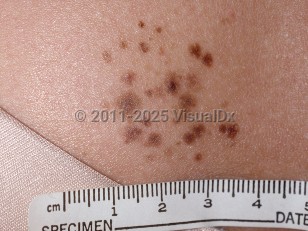Agminated nevus
Alerts and Notices
Important News & Links
Synopsis

An agminated nevus consists of a cluster of nevi confined to a localized area of the skin, usually smaller than 10 cm in diameter. The intervening skin between lesions is usually normal but may show a speckled pigmentation.
Agminated nevi may consist of benign melanocytic nevi, atypical or dysplastic nevi, blue nevi, or Spitz nevi. Agminated nevi may be congenital or acquired. Agminated common melanocytic and atypical nevi are invariably acquired. If the lesions are acquired, they typically develop during puberty and may continue to evolve in early adolescence.
Agminated nevi are thought to arise as a result of loss of heterozygosity (LOH) occurring in a somatic cell during embryogenesis. This results in an area of skin populated by cells that are homozygous or hemizygous for the major gene responsible for the development of melanocytic nevi.
The etiology of acquired agminated Spitz nevi is unknown, but numerous causes have been postulated including previous excision of solitary Spitz nevi, sunburn, and radiation therapy.
There is some evidence to suggest that a genetic association exists between agminated common and dysplastic nevi and familial atypical nevus syndrome phenotypes. In this context, agminated nevi are thought to arise as a consequence of postzygotic LOH, thus representing a type 2 segmental manifestation of the familial atypical mole syndrome phenotype. However, microdissection techniques to analyze an LOH pattern have not confirmed this theory. Agminated blue nevus has been speculated to arise from earlier postzygotic mutations in the GNAQ and GNA11 genes.
Agminated blue nevus has been described in conjunction with EMO (exophthalmus, pretibial myxoedema, osteoarthropathia) syndrome / Carney complex (caused by mutations in PRKAR1A), dermatomyositis, and Darier disease.
Although the risk for malignant change of agminated melanocytic nevi has not yet been defined, melanoma arising from agminated melanocytic nevi has been described. These patients should thus be considered at higher risk for subsequent melanoma development.
Agminated nevi may consist of benign melanocytic nevi, atypical or dysplastic nevi, blue nevi, or Spitz nevi. Agminated nevi may be congenital or acquired. Agminated common melanocytic and atypical nevi are invariably acquired. If the lesions are acquired, they typically develop during puberty and may continue to evolve in early adolescence.
Agminated nevi are thought to arise as a result of loss of heterozygosity (LOH) occurring in a somatic cell during embryogenesis. This results in an area of skin populated by cells that are homozygous or hemizygous for the major gene responsible for the development of melanocytic nevi.
The etiology of acquired agminated Spitz nevi is unknown, but numerous causes have been postulated including previous excision of solitary Spitz nevi, sunburn, and radiation therapy.
There is some evidence to suggest that a genetic association exists between agminated common and dysplastic nevi and familial atypical nevus syndrome phenotypes. In this context, agminated nevi are thought to arise as a consequence of postzygotic LOH, thus representing a type 2 segmental manifestation of the familial atypical mole syndrome phenotype. However, microdissection techniques to analyze an LOH pattern have not confirmed this theory. Agminated blue nevus has been speculated to arise from earlier postzygotic mutations in the GNAQ and GNA11 genes.
Agminated blue nevus has been described in conjunction with EMO (exophthalmus, pretibial myxoedema, osteoarthropathia) syndrome / Carney complex (caused by mutations in PRKAR1A), dermatomyositis, and Darier disease.
Although the risk for malignant change of agminated melanocytic nevi has not yet been defined, melanoma arising from agminated melanocytic nevi has been described. These patients should thus be considered at higher risk for subsequent melanoma development.
Codes
ICD10CM:
D22.9 – Melanocytic nevi, unspecified
SNOMEDCT:
402555001 – Multiple benign melanocytic nevi
D22.9 – Melanocytic nevi, unspecified
SNOMEDCT:
402555001 – Multiple benign melanocytic nevi
Look For
Subscription Required
Diagnostic Pearls
Subscription Required
Differential Diagnosis & Pitfalls

To perform a comparison, select diagnoses from the classic differential
Subscription Required
Best Tests
Subscription Required
Management Pearls
Subscription Required
Therapy
Subscription Required
References
Subscription Required
Last Reviewed:05/16/2021
Last Updated:08/15/2021
Last Updated:08/15/2021
Agminated nevus

